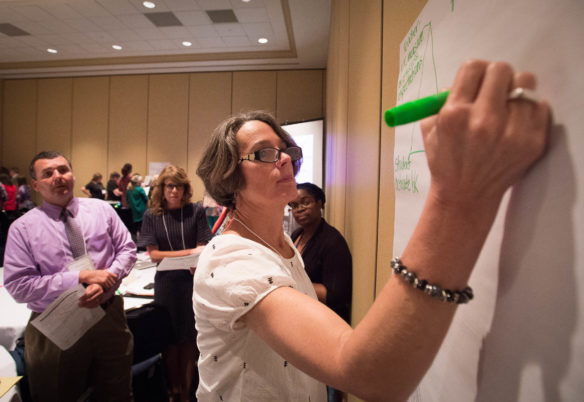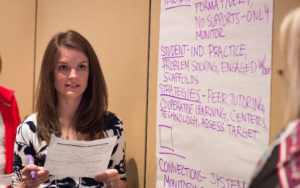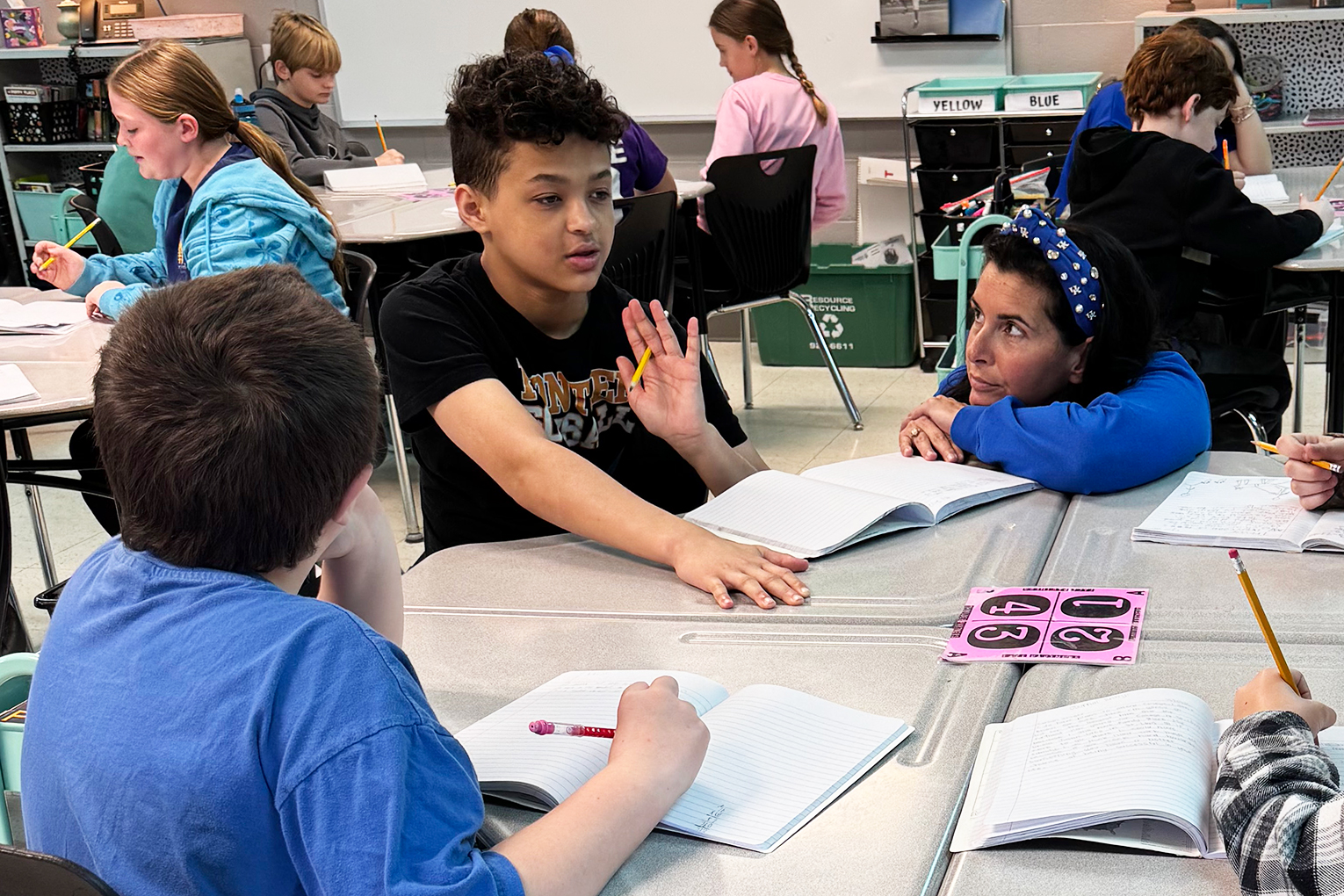
Kathy House, chief academic officer of Trimble County Schools, writes different strategies to help with novice reduction during a session at the 2016 Kentucky Continuous Improvement Summit in Lexington.
Photo by Bobby Ellis, Sept. 20, 2016
Brenna R. Kelly
Brenna.kelly@education.ky.gov
At Garrard County’s Lancaster Elementary School, the number of students performing at the novice level in mathematics on state assessments dropped 9 percent in one year. The number of students reading at the novice level, the lowest of the four assessment categories in Kentucky Performance Rating for Educational Progress dropped 4.1 percent.
The reason, Superintendent Corey Keith recently told the Kentucky Board of Education, was the Kentucky Department of Education’s Novice Reduction for Gap Closure initiative.
“Our experience with novice reduction has been very powerful,” Keith said. “Our philosophy is if there’s a way to get better, we want to get better.”
The school, which is now ranked Proficient/Progressing, was one of 12 pilot schools or districts to take part in the initiative during the 2015-16 school year. The novice reduction initiative is designed to improve classroom instruction in order to reduce the number of students performing at the lowest level.
A staff of six novice reduction coaches already has worked with 4,700 educators across the state to help implement strategies designed to improve student achievement, said Kelly Foster, associate commissioner of KDE’s Office of Continuous Improvement and Support. KDE officials believe that by targeting novice learners, achievement gaps between specific groups of students – such as minorities and students in poverty – and their white or more economically advantaged classmates will begin to close.
In the first year, the percent of novice students in the 12 pilot schools and districts decreased in reading at the middle and high school levels. Schools and districts not in the pilot actually saw the percent of novice learners in reading increase at the elementary and middle school levels.
In mathematics, schools in the pilot project saw reductions in the percent of novice learners at the elementary, middle and high school levels. In districts and schools not involved in the pilot, the percent of novices in mathematics increased at the middle school level, yet decreased at the elementary and high school level.
“It’s really powerful to realize that people are embracing this work,” Foster said. “And we are seeing some movement. It needs to happen faster, but we have strong momentum right now and have everyone’s attention around closing the achievement gap in Kentucky.”
In addition to the pilots, KDE staff also has begun working with several other districts this school year, including Jefferson County, the Commonwealth’s largest school district.
“We know that if we’re going to close that achievement gap, we have to partner with Jefferson County,” Foster said.
Novice reduction coaches now receive so many requests from schools and districts that they have to work hard to keep up with the demand, said Linda Rains, novice reduction coordinator.
“We are typically two to three places within a day,” she said. “The need is great. We appreciate the calls and response to the work that we suggest.”
Schools and districts also can use the Novice Reduction website, which has tools to help them get started. In August and September, nearly 13,000 people used the website, Rains said.
“We do not sell novice reduction as an easy task,” she said. “It’s not quick fixes. These are big, sustainable changes that have to take place in our schools and districts.”
The staff will train 6,800 educators this fall at six-hour workshops being held in October and November, Foster said. Some educators also attended several mini-workshops at the 2016 Continuous Improvement Summit last month in Lexington.
At one of the sessions, Novice Reduction Coach Wanetta Morrow showed educators two of the top strategies that have been proved to make a large impact on student achievement – metacognition and direct explicit instruction.
Metacognitive strategies
Using Metacognitive strategies can improve student achievement more than 1.5 times the amount of typical student growth for an entire year, Morrow said.
Metacognition is thinking about thinking; it’s knowing what you don’t know, she said. For example, another novice reduction coach recalled reading the children’s book “Corduroy,” to students in eastern Kentucky.
“When Corduroy goes up the escalator, it was hard for the students to envision what that might be like,” she said. “They weren’t familiar with what an escalator was.”
Teachers need to be aware of their students’ prior knowledge and also be able to help the students articulate what they are having trouble learning.
“Most of our students do know something about what’s being taught, but maybe there’s one part that they are struggling with,” Morrow said. “So as teachers we need to be very intentional about helping students pinpoint what they know and also what they don’t know.”
One example of getting students to think about their learning is to put cups in the center of a table with questions students can pick out, for example, “Do I understand what I just saw/heard/read?” or “Do I know where to get more information.”
“We want our students to be active and thinking about what they know and don’t know,” Morrow said, “not to be passive learners.”
Direct Explicit Instruction

Julie Hoff, a curriculum specialist at Pulaski County High School, works on a chart about direct explicit instruction during a novice reduction seminar at the 2016 Kentucky Continuous Improvement Summit in Lexington.
Photo by Bobby Ellis, Sept. 20, 2016
The second strategy – direct explicit instruction – includes teachers using research-based strategies to explain the content, demonstrating the concept for students, using student-engagement strategies during the lesson and then checking for students’ understanding.
“We need to get away from the myth that direct instruction is very rote and very structured and very teacher directed,” Morrow said.
Direct explicit instruction includes four phases: direct explanation, demonstration and modeling, guided practice and independent practice.
The lessons could use formative assessment, Kagan strategies, question strategies or any other proven technique, she said. The goal is to keep the students active while learning by asking them to do something frequently, such as sharing with a partner, reading with the teacher, using a whiteboard to write answers or making journal entries.
The frequent interaction helps teachers know if students are learning the concepts or if he or she needs to try another method of teaching.
Eventually, students work independently to demonstrate what they have learned. Some examples include problem solving, leading discussions and questioning their thinking.
Though the two strategies can have a big impact, they should be one part of a systemic change that embraces continuous improvement in the school or district, Morrow said.
“Novice reduction is a year-long process, it’s not just a one-shot deal,” she said.
At the 2016 Continuous Improvement Summit, Kathy House, chief academic officer for Trimble County Schools said her district has been working on novice reduction for the past two years. The district learned many of the novice reduction strategies after its high school was named a priority school, she said.
After rebuilding its professional learning communities to focus on student engagement using the strategies, the district is now rated Distinguished.
“It’s really empowering students,” House said. “I think the biggest change is shifting from the teacher as the imparter of information to the teacher being the facilitator of learning and getting the students to take that ownership.”
MORE INFO …
Wanetta Morrow Wanetta.Morrow@education.ky.gov
Linda Rains Linda.Rains2@education.ky.gov
Kelly Foster Kelly.Foster@education.ky.gov
Kathy House Kathy.House@trimble.kyschools.us
MORE KENTUCKY TEACHER STORIES ON NOVICE REDUCTION
State will focus on Novice reduction to close achievement gaps
Taking on the gap
Sharing experiences to get it right




Leave A Comment